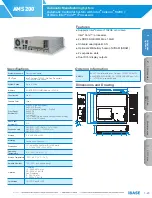
Lucent Technologies Lineage
®
2000 ECS Battery Plant H569-403
Issue 4 February 1997
Engineering, Planning, and Ordering 3 - 29
(5C) Circuit Figures: There is often a Wiring Diagram
(T-drawing) which is separate from the assembly drawing for
equipment that incorporates factory wiring. If a List contains
wiring, the associated Figure number of the T-drawing is
indicated in Table A of the J-drawing. A quantity indicates the
number of multiples of the wiring in the specified figure which
are required for a List. When a T-drawing figure is not listed in
parentheses, everything in the figure which is not indicated as
optional is provided. (See below for a detailed discussion of
T-drawing options.) When a T-drawing figure is listed in
parentheses, only the indicated wiring or apparatus options are
provided from that figure.
(5D) Wiring Options: If portions of the wiring are connected
differently among the Lists, those differences are indicated by
T-drawing Wiring Options.
(5E) Apparatus Options: When circuit components differ
from one List to another, these differences are indicated by
Apparatus Options on the T-drawing.
(6) Table C: This table cross-references the schematic (SD) and
wiring diagram (T).
(7) Table D: This table provides a list of all associated
drawings, such as other J-, ED- or H-coded equipment that must
be ordered separately. Drawings which are required for
engineering or manufacturing but are not necessary for
installation are indicated by an equals-sign (=).
(8) Manufacturing Notes & Symbols: Notes that apply to
factory and/or field assembly are listed as Manufacturing Notes
and are numbered from 1 to 50. The first several notes define
standard symbols used on the assembly views and in the stocklist
to indicate stamping and factory packaging methods. Additional
manufacturing notes are specific to each J-drawing. All
manufacturing notes should be read and understood by
engineering, as well as installation, since they may include
important installation details that the engineer must plan for.
(9) Engineering Notes: For engineering, the second most
important part of the J-drawing, after Table A, is the Engineering
Notes section. These notes, starting at Note 51, provide such
information as:
•
Restrictions on List combinations
















































